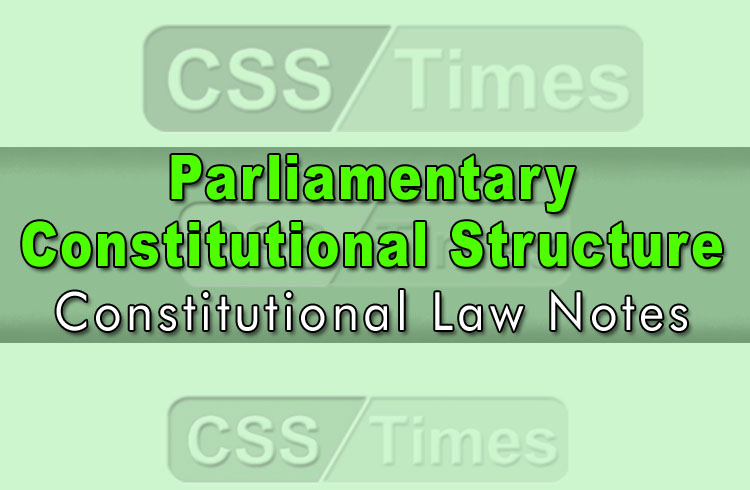Parliamentary – Constitutional Structure
CSS Constitutional Law Notes
The modern concept of prime ministerial government originated in the Kingdom of Great Britain (1707–1800) and its contemporary, the Parliamentary System in Sweden (1721–1772)
In a parliamentary system, by contrast, the legislature holds supreme power. The prime minister is chosen by members of the legislature (Parliament) from among their own number and in practice is the leader of the majority party in the legislature. The cabinet members must also belong to the legislature, where they are subject to the same kind of questioning that the prime minister experiences. If the prime minister loses the support of the majority in the legislature on a significant vote, he or she must resign, and elections are called immediately. Thus, whereas in the United States, elections are held at fixed intervals, in Britain and other parliamentary countries, they may occur at any time, the only restriction being (in Britain) that they must be held at least once every five years.
This form of government exists in countries like Britain, Pakistan, India and Canada. The Features of Parliamentary Form of Government has been discussed below:
Features
1. Existence of a Titular or Constitutional Ruler: The first characteristic feature of the parliamentary system is the existence of a Titular of Constitutional Ruler. Legally the administration of all the affairs of the state is conducted by the head of the state. In reality, however, the administration is carried on in his name by the Council of Ministers. He is the head of the state, but not the head of the government.
2. Absence of Separation of Powers: In the parliamentary system the principle of separation of powers is not adopted. Here the three departments of government work in close, intimate contact, sharing some of the powers and functions of one another.
3. Main Role of the Lower House in Ministry-formation: In the parliamentary government the lower house of the legislature, i.e., the popular chamber plays a vital role in the formation of the ministry. The leader of the party or alliance which wins the majority in this house is appointed the Prime Minister or Chancellor. The constitutional ruler appoints the other members of the ministry on his advice.
4. Responsibility to the Legislature: In such a system the Cabinet or Ministry has to remain responsible to the legislature for all its activities and policies. In countries having bi-cameral legislatures, the Cabinet remains responsible to the lower house composed of the people’s representatives.
Check also: 10 Fascinating Facts about World War I
5. Collective Responsibility: The ministerial responsibility to the legislature may again be of two kinds:
o Individual responsibility, and
o Collective responsibility.
o Individual responsibility means that the minister in charge of a department must be answerable for the activities of his department. But when the ministers remain jointly or collectively responsible to the legislature for the policies and activities of the government, it is called ‘collective responsibility’. Since no individual minister can unilaterally perform any business of government without the consent of the Cabinet, the entire Ministry or Cabinet has to remain accountable for the errors of the minister concerned.
6. Intimate relationship between the Legislature and the Executive: In the parliamentary system an intimate relationship exists between the executive and the legislative departments. So they can easily control each other. The leaders of the majority party or alliance in the legislature become the members of the Cabinet or Ministry. Naturally, the ministers can easily extend their influence on the legislature. Consequently, the programs and policies of the Cabinet are backed by a majority inside the legislature.
7. Leadership of the Prime Minister: The leadership of the Prime Minister is another major feature of the parliamentary system. The leader of the majority party in the legislature becomes the Prime Minister. Though, in theory, he is ‘primus inter pares’, i.e. ‘first among equals’, in reality, he possesses much greater power and status than the other ministers. As the undisputed leader of the majority party or alliance in the legislature he plays the most vital role in the determination and execution of government policies. Indeed, the success of parliamentary democracy depends, to a great extent, on the personality, efficiency and charisma of the Prime Minister.
Read Also: The Concept of -Rule or Law | CSS Constitutional Law Notes
8. Existence of a Strong Opposition: The existence of one or more strong and well-organized opposition party or parties is the hall-mark of the parliamentary system. By criticizing the errors of the government, the opposition can compel it to adopt welfare measures and prevent it from becoming despotic. Judged from this angle, the opposition can be called the life-force of parliamentary democracy.
9. Cabinet Dictatorship: In the parliamentary system of government the cabinet has to perform manifold functions. It is the Cabinet which:
- formulates well-considered policies of the Government after reviewing both the national and international issues,
- takes necessary, arrangements for passing laws to implement the policies formulated by it,
- determines the matters to be included in the agenda of the central legislature,
- controls and directs the administrative departments so that laws, Government orders, etc. are to be implemented properly,
- co-ordinates the activities of different departments of the Government,
- prepares the draft budget in consultation with the Prime Minister and takes necessary initiative to get it passed in the legislature,
- formulates economic policies and takes necessary steps for implementing the same,
- Advice’s the constitutional head to take necessary action during emergency or unforeseen situation, etc.
In this way the Cabinet acts as ‘the keystone of the political arch’ or has become the ‘steering wheel of the ship of fact of the state’. In fact, in the parliamentary system of government as the cabinet members are the leaders of the majority party or alliance in the legislature and the head of the state is nothing but a magnificent cipher, the Cabinet under the leadership of the Prime Minister has virtually become dictator.
Countries by Parliamentary Systems
Africa
| Country | Connection between legislative and executive branch |
| Botswana | Parliament of Botswana elects the President who appoints the Cabinet |
| Ethiopia | Federal Parliamentary Assembly appoints the Council of Ministers |
| Mauritius | National Assembly appoints the Cabinet of Mauritius |
| Somalia | |
| South Africa | Parliament of South Africa elects the President who appoints the Cabinet of South Africa |
Americas & the Caribbean
| Country | Connection between legislative and executive branch |
| Antigua and Barbuda | Parliament of Antigua and Barbuda approves the Cabinet of Antigua and Barbuda |
| Bahamas, The | Parliament of the Bahamas approves the Cabinet of the Bahamas |
| Barbados | Parliament of Barbados approves the Cabinet of Barbados |
| Belize | National Assembly approves the Cabinet of Belize |
| Canada | Leader of the political party that has the support of a majority in the House of Commons of Canada is appointed Prime Minister of Canada by the Governor General of Canada, who then appoints the Cabinet of Canada on the advice of the Prime Minister |
| Dominica | Parliament approves the Cabinet of Dominica |
| Grenada | Leader of the political party that has the support of a majority in the House of Representatives of Grenada is appointed Prime Minister of Grenada by the Governor-General of Grenada, who then appoints the Cabinet of Grenada on the advice of the Prime Minister |
| Jamaica | Parliament of Jamaica appoints the Cabinet of Jamaica |
| Saint Kitts and Nevis | National Assembly elects the Prime Minister of Saint Kitts and Nevis |
| Saint Lucia | Parliament of Saint Lucia appoints the Prime Minister of Saint Lucia |
| Saint Vincent and the Grenadines | House of Assembly appoints the Prime Minister of Saint Vincent and the Grenadines |
| Suriname | National Assembly elects the President, who appoints the Cabinet of Suriname |
| Trinidad and Tobago | Parliament of Trinidad and Tobago approves the Prime Minister of Trinidad and Tobago |
Asia
| Country | Connection between legislative and executive branch |
| Bangladesh | Jatiyo Sangshad appoints the Cabinet of Bangladesh |
| Bhutan | Parliament of Bhutan approves the Lhengye Zhungtshog |
| Cambodia | Parliament of Cambodia approves the Council of Ministers |
| India | Lok Sabha approves the Prime Minister of India who then forms the Cabinet of India |
| Iraq | Council of Representatives approves the Cabinet of Iraq |
| Israel | Knesset approves the Cabinet of Israel |
| Japan | National Diet nominates the Prime Minister who appoints the Cabinet of Japan |
| Kuwait | National Assembly approves the Crown Prince who appoints the Prime Minister who appoints the Cabinet of Kuwait |
| Kyrgyzstan | Supreme Council approves the Cabinet of Kyrgyzstan |
| Lebanon | Parliament of Lebanon approves the Cabinet of Lebanon |
| Malaysia | Parliament of Malaysia appoints the Cabinet of Malaysia |
| Myanmar | Assembly of the Union, by an electoral college, elects the President who forms the Cabinet of Myanmar |
| Nepal | Parliament of Nepal elects the Prime Minister who, by turn, appoints the Cabinet of Nepal |
| Pakistan | Parliament of Pakistan appoints the Cabinet of Pakistan |
| Singapore | Parliament of Singapore approves the Cabinet of Singapore |
| Thailand | House of Representatives appoints the Prime Minister who appoints the Cabinet of Thailand |
Europe
| Country | Connection between legislative and executive branch |
| Albania | Parliament of Albania approves the Cabinet of Albania |
| Austria | National Council can dismiss the Cabinet of Austria through a motion of no confidence |
| Belgium | Federal Parliament approves the Cabinet of Belgium |
| Bulgaria | National Assembly appoints the Council of Ministers of Bulgaria |
| Croatia | President of the Republic of Croatia appoints the President of the Government (Prime Minister) who must have confidence of the Croatian Parliament. The President of the Government forms cabinet (Croatian Government) after confidence being given to the program and the members of the Croatian Government by the Croatian Parliament |
| Czech Republic | President of the Czech Republic appoints the leader of the largest party or coalition in the Parliament as Prime Minister, who forms the Cabinet |
| Denmark | The Monarch appoints, based on recommendations from the leaders of the parties in Folketinget, the cabinet leader who is most likely to successfully assemble a Cabinet which will not be disapproved by a majority in Folketinget. |
| Estonia | Riigikogu appoints the Government of the Republic of Estonia |
| Finland | Parliament of Finland appoints the Cabinet of Finland |
| Germany | Bundestag elects the Federal Chancellor, who forms the Cabinet |
| Greece | Hellenic Parliament approves the Cabinet of Greece |
| Hungary | National Assembly approves the Cabinet of Hungary |
| Iceland | Althing appoints the Cabinet of Iceland |
| Ireland | Oireachtas appoints the Government of Ireland |
| Italy | Italian Parliament grants and revokes its confidence in the Cabinet of Italy, appointed by the President of Italy |
| Kosovo | Assembly of Kosovo appoints the Government of Kosovo |
| Latvia | Saeima appoints the Cabinet of Ministers of the Republic of Latvia |
| Luxembourg | Chamber of Deputies appoints the Cabinet of Luxembourg |
| Macedonia | Assembly approves the Government of Macedonia |
| Malta | House of Representatives appoints the Cabinet of Malta |
| Moldova | Parliament of Moldova appoints the Cabinet of Moldova |
| Montenegro | Parliament of Montenegro appoints the Government of Montenegro |
| Netherlands | Staten-General appoints the Cabinet of the Netherlands |
| Norway | The Monarch appoints the MP leading the largest party or coalition in Stortinget as Prime Minister, who forms the Cabinet |
| Poland | Parliament of Poland approves the Cabinet of Poland |
| Serbia | National Assembly appoints the Government of Serbia |
| Slovakia | National Council approves the Government of Slovakia |
| Slovenia | National Assembly appoints the Government of Slovenia |
| Spain | The Congress of Deputies elects the President of the Government, who forms the Cabinet |
| Sweden | The Riksdag elects the Prime Minister, who in turn appoints the other members of the Government |
| Turkey | Grand National Assembly approves the Cabinet of Turkey |
| United Kingdom | The Monarch appoints the MP leading the largest party or coalition in the House of Commons as Prime Minister, who forms the Cabinet |
Pacific
| Country | Connection between legislative and executive branch |
| Australia | Parliament of Australia appoints the Cabinet of Australia |
| New Zealand | Parliament of New Zealand appoints the Cabinet of New Zealand |
| Papua New Guinea | National Parliament appoints the Cabinet of Papua New Guinea |
| Samoa | Legislative Assembly appoints the Cabinet of Samoa |
| Vanuatu | Parliament of Vanuatu appoints the Cabinet of Vanuatu |







